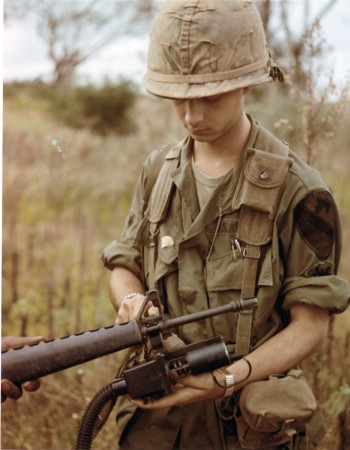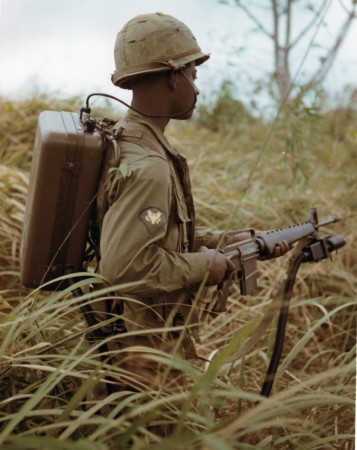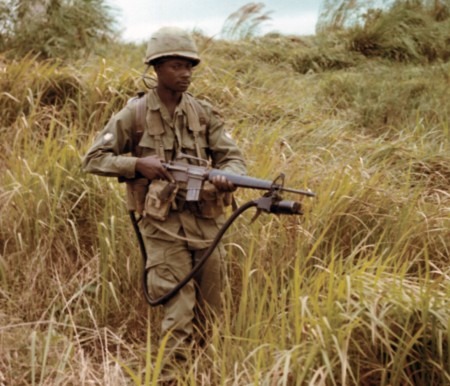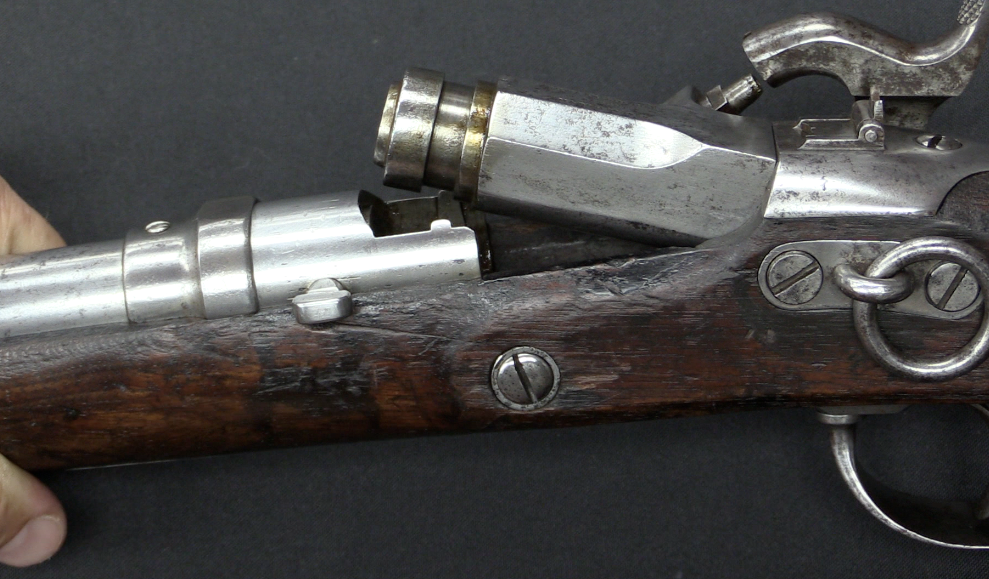
by Tom Laemlein
In the rather deadly game of “hide & seek” played by the US Army and the Viet Cong led to a rather bizarre technical innovation during the Vietnam War: the people sniffer. The detection technology was developed by General Electric for the US Army’s Chemical Corps. “People Sniffer” technology was based on locating hidden enemy troops by detecting the chemical traces of urine and sweat. The sweatier or more piss-soaked that the VC were, so much the better for the People Sniffer, if not so much the operator!

The first version of the People Sniffer was the XM-2 personnel detector man-pack (also known as the E63 man-pack personnel detector). The XM-2 consisted of a backpack-mounted sensor, coupled with an air intake tube mounted on the end of a M16 rifle. Deployed during 1967, reports are that the XM-2 was often a bit too sensitive, and would only pick up the sweat odors of its user. This, coupled with the rather loud “ticka-ticka-ticka” noise that sensor made while in use rather gave the whole game away. Understandably, troops were uncomfortable carrying a heavy noisemaker into an ambush zone. So the XM-2 man-portable system gave way to the much more powerful XM-3 airborne platform, normally mounted on a helicopter. The XM-3 delivered much better results, although the Viet Cong eventually learned ways to deceive the device’s ability to detect sweat, urine and campfire smoke.
If you can find an XM-2 “personnel detector” out there somewhere, it will make a great accessory for your vintage M16A1 rifle—granted you can find one of those.
https://www.youtube.com/watch?v=w2W6IbdPTgQ
Tom Laemlein runs Armor Plate Press, a military history publishing company that specializes in producing photo studies of 20th Century weapons systems. Find his work at www.armorplatepress.com.




I remember reading that there was a larger, helicopter based version of this that was trialled. It had similar faults to the man portable version.The VC used to have urine filled Buffalo bladders on ropes 100’s of feet in lenght, then draw the chopper into an ambush. Hi-Tech meets Low-Tech.
Now if that’s not imaginative I don’t know what is! Granted it probably wouldn’t be the most effective means of finding Charlie, but I gotta give it points simply for being like something straight out of science fiction.
As I recall, the prototypes were decidedly “low tech.” I’ve read several accounts where the early versions of this device consisted of a box of hungry bedbugs. When the bedbugs smelled “prey,” they became agitated, and the sound of their movement was amplified so the detector could home-in on the enemy’s position. I guess the electronic method was less troublesome than the biological version.
Um, no. The people sniffer worked by collecting ambient air and basically measuring the change in electrical current in a cloud of chemicals. It was a modification of earlier technology for the Navy to detect diesel emissions from Soviet submarines. Sorry, no bedbugs were harmed in the making of the People Sniffer..
What you’re thinking of was an entirely different idea out of the Limited War Lab at Aberdeen; a detector based on the fact cockroaches would vibrate in the presence of human beings. An unattended ground sensor was made by gluing a cockroach to a record player cartridge and then connecting the output to a transmitter. When humans came near the sensor a signal would be transmitted.
Now bedbugs were mentioned as an “ambush sensor” in the report titled THE USE OF ARTHROPODS AS PERSONNEL DETECTORS but that had nothing to do with General Electric’s development of the People Sniffer. The report may be downloaded from here https://apps.dtic.mil/sti/citations/AD0837100
Oh, Civil Rights… The large, 24 lb machine that makes a location broadcasting noise, and in the only picture I’ve seen of it, it’s given to the black soldier. Given by the look on his face, he may share my skepticism. 😉 Though they did use a white guy for this informative video http://youtu.be/w2W6IbdPTgQ .
With all the noise, this was perhaps a more effective personnel detector for the VC than for the U.S. troops?
Cool video! I added it to the post.
A more advanced version of the airborne variant was later mounted on the Air Force “gunships”, notably the AC-119K and AC-130A/E. Their main purpose was to either zero in on VC attempting a night assault on a firebase (AC-119), or finding the “porters” who ran supplies down the Ho Chi Minh trail on bicycles (AC-130). So they could then be dealt with by 7.62mm Minigun or 20mm Vulcan fire, not 5.56mm.
Either one seems a more sensible deployment of the technology that the man-“portable” version.
Of course, a modern-day version would probably be no larger or heavier than a third-generation laser sight of the sort used on the MK 23 SOCOM .45 pistol. And probably wouldn’t make that annoying “tick”, ether.
More like a Sidewinder, probably. Get “tone”, pull trigger.
cheers
eon
Also, does Mr. Laemlein know about the copyright information on the photos shown above? If they are public domain, etc, I’d be more than happy to update the Wikipedia page for this device, which currently contains no photos.
I’m sure he does know the copyright status, but I don’t. I’ll ask him…
I would have thought that it would be pretty obvious that a sensor of that sort would be much more likely to pick up an operator at arm’s reach away rather than someone else a hundred metres away.
The only way that something like this could work is if you could guaranty a steady but gentle breeze blowing in the direction from the enemy to the operator. Putting that sort of limitation on the equipment really limits the tactical practicality of it to the point of it not being worth the effort of lugging it around (at the expense of something else you could be carrying instead).
Airborne and unmanned stationary installations may be a different matter, but here we are talking about the man-portable version.
In Afghanistan there is a big emphasis on thermal imaging sensors to detect body heat at night. It works well in the clear, dry, desert air where there is also a lack of vegetation to obscure the view. It would be interesting to see how well this modern day sensor would work in humid jungles under real field conditions (as opposed to staged test scenarios).
It is a known property of thermal imaging sensors that fog and certain types of rain (particularly drizzle) make them less useful. High humidity itself has virtually no effect, since water vapor does not readily absorb or scatter long IR (“heat”) radiation enough to have hinder the process. There are ways to camouflage against heat sensors, but in general thermal imaging is already a fairly established way of detecting people and heat generating equipment (like vehicles). It works particularly well against enemy on the move, or one that is not “heat aware” and has not learned anti-thermal camouflage methods.
The “TRIM” project with VAH-21 dropped “Sensors” along the Ho Chi Minh trail in the late 60s. Mostly acoustic and oder sensors, the most exotic was calibrated with female Asian elephant urine supplied,allegedly, by the San Diego zoo. The only surviving AP-2H sits in the Pima Air & Space Museum. My flight station was in the nose, so as to be first to the crash site :-p
BMV
Amazing technology, very cool.
Might have been handy for “sniffing” out covered tunnel entrances…
I bet these days there’s versions of it still in use, handle some money with a chemical “smell” on it, to which the device was calibrated for and it could sniff it in your pocket elsewhere etc.
I suppose a alcohol breathalyser might be related to it, as a sort of air analysis device.
Did it really work? I have extremly strong doubts that it ever worked. Imagine the wind comes from your back side – you would sniff yourself all the time. Then there are tons of other animals and vegetation that produces chemicals similiar to humans. It cannot possibly work outside lab conditions.
@shooter8 :
Great information — thanks for sharing such a rare insight, and moreover by one who was actually there! I would think the ADSID ( Air-Delivered Seismic Intrusion Device ) programme for interdicting the Ho Chi Minh Trail eventually proved a lot more successful than the acoustic and odor-detection programmes, even if the former was still subject to certain operational limitations.
Also, many thanks to Tom Laemlein and Ian McCollum for providing us with such interesting information on one of the less well-known aspects of Vietnam War history.
The RAF used a system called Autolycus to detect diesel exhaust from snorkelling subs…the only thing they actually seemed to detect was trawlers and was eventually withdrawn from service.
The VC used to hang pots of urine from trees to lure the US to attack “troop concentration”, the US were clever to think it up and the NVA/VC was clever to think up a counter.
One must give credit for trying something new, even if it didn’t work as well as expected. However I must say it is a shame there were no easily trained canines with keen olfactory senses that can distinguish between friends and strangers that were already in service and had a track record of uncovering traps and enemies.
I was a pilot with the Gambler guns aug ’68 to aug ’69. The Scorpion (people sniffer) mission was one of our regular missions.
John Parker… me too. I was a snoopy operator and flew a lot of missions (at least 200)with the SCORPION team. The SCORPION team typically consisted of two OH-6A Loaches and 2 AH-1G gunships. One Loach carried the APD (Airborne Personnel Detector) on the deck, the second Loach was the chase ship that marked the map and also carried E-158 tear gas munitions. The Loaches would follow up the sniffing with hovering over hot spots to further pinpoint the enemy.
Did you know that SCORPION is an acronym for Special Combined Operations for Personnel Identification and Overt Neutralization? I was the Personnel Identification part of that. You were the Overt Neutralization. (-:
Oh, we flew the later version of the APD, the XM3. SCORPION started around Mar ’69 and I flew until Jul ’69 when I DEROS’d. I certainly remember the Gambler guns! Thank you for your service.
It seems a pretty obvious (not exactly) failsafe procedure to detect an enemy troop…he’s the guy shooting at you.